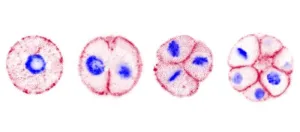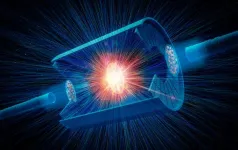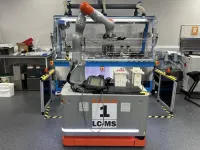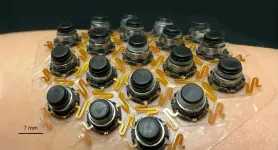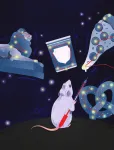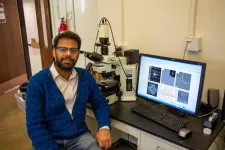(Press-News.org) Chromosphaera perkinsii is a single-celled species discovered in 2017 in marine sediments around Hawaii. The first signs of its presence on Earth have been dated at over a billion years, well before the appearance of the first animals. A team from the University of Geneva (UNIGE) has observed that this species forms multicellular structures that bear striking similarities to animal embryos. These observations suggest that the genetic programmes responsible for embryonic development were already present before the emergence of animal life, or that C. perkinsii evolved independently to develop similar processes. Nature would therefore have possessed the genetic tools to “create eggs” long before it “invented chickens”. This study is published in the journal Nature.
The first life forms to appear on Earth were unicellular, i.e. composed of a single cell, such as yeast or bacteria. Later, animals - multicellular organisms - evolved, developing from a single cell, the egg cell, to form complex beings. This embryonic development follows precise stages that are remarkably similar between animal species and could date back to a period well before the appearance of animals. However, the transition from unicellular species to multicellular organisms is still very poorly understood.
Recently appointed as an assistant professor at the Department of Biochemistry in the UNIGE Faculty of Science, and formerly an SNSF Ambizione researcher at EPFL, Omaya Dudin and his team have focused on Chromosphaera perkinsii, or C. perkinsii, an ancestral species of protist. This unicellular organism separated from the animal evolutionary line more than a billion years ago, offering valuable insight into the mechanisms that may have led to the transition to multicellularity.
By observing C. perkinsii, the scientists discovered that these cells, once they have reached their maximum size, divide without growing any further, forming multicellular colonies resembling the early stages of animal embryonic development. Unprecedentedly, these colonies persist for around a third of their life cycle and comprise at least two distinct cell types, a surprising phenomenon for this type of organism.
‘‘Although C. perkinsii is a unicellular species, this behaviour shows that multicellular coordination and differentiation processes are already present in the species, well before the first animals appeared on Earth’’, explains Omaya Dudin, who led this research.
Even more surprisingly, the way these cells divide and the three-dimensional structure they adopt are strikingly reminiscent of the early stages of embryonic development in animals. In collaboration with Dr John Burns (Bigelow Laboratory for Ocean Sciences), analysis of the genetic activity within these colonies revealed intriguing similarities with that observed in animal embryos, suggesting that the genetic programmes governing complex multicellular development were already present over a billion years ago.
Marine Olivetta, laboratory technician at the Department of Biochemistry in the UNIGE Faculty of Science and first author of the study, explains: “It’s fascinating, a species discovered very recently allows us to go back in time more than a billion years”. In fact, the study shows that either the principle of embryonic development existed before animals, or multicellular development mechanisms evolved separately in C. perkinsii.
This discovery could also shed new light on a long-standing scientific debate concerning 600 million-year-old fossils that resemble embryos, and could challenge certain traditional conceptions of multicellularity.
END
The egg or the chicken? An ancient unicellular says egg!
A cell division resembling that of an animal embryo has been observed in a prehistoric unicellular organism, suggesting that embryonic development might have existed prior to the evolution of animals
2024-11-06
ELSE PRESS RELEASES FROM THIS DATE:
Coping and resilience aids parents of disabled children, study says
2024-11-06
OXFORD, Miss. – For parents of children with disabilities, finding time to focus on themselves may be difficult. However, a new study finds that the right coping strategies and resilience can significantly help manage the challenges of raising children with special needs.
That is the key finding from research published in the International Journal of Developmental Disabilities that studied families with neurodevelopmentally disabled children in Ghana to see what helps parents cultivate healthy, happy lives for themselves and their children.
“Our main interest ...
Lupus Research Alliance announces inaugural recipients of Translational Bridge Award
2024-11-06
New York, NY. November 6, 2024. The Lupus Research Alliance (LRA) is excited to announce the first-ever recipients of the Translational Bridge Award (TBA), established this year to accelerate the translation of groundbreaking research into potential treatments and diagnostics for lupus. The award aims to propel high-potential projects from LRA-funded foundational discoveries with strong commercialization potential or an opportunity for clinical evaluation. Five exceptional researchers have been awarded the 2024 Translational Bridge Award to tackle pressing ...
Brain stars hold our memories
2024-11-06
A study published in Nature by researchers at Baylor College of Medicine changes the way we understand memory. Until now, memories have been explained by the activity of brain cells called neurons that respond to learning events and control memory recall. The Baylor team expanded this theory by showing that non-neuronal cell types in the brain called astrocytes – star-shaped cells – also store memories and work in concert with groups of neurons called engrams to regulate storage and retrieval of memories.
“The prevailing idea is that the formation and recall of memories only involves neuronal engrams that are activated by certain ...
Imaging nuclear shapes by smashing them to smithereens
2024-11-06
UPTON, N.Y. — Scientists have demonstrated a new way to use high-energy particle smashups at the Relativistic Heavy Ion Collider (RHIC) — a U.S. Department of Energy (DOE) Office of Science user facility for nuclear physics research at DOE’s Brookhaven National Laboratory — to reveal subtle details about the shapes of atomic nuclei. The method, described in a paper just published in Nature, is complementary to lower energy techniques for determining nuclear structure. It will add depth to scientists’ understanding of the nuclei that make up the ...
AI-driven mobile robots team up to tackle chemical synthesis
2024-11-06
Researchers at the University of Liverpool have developed AI-driven mobile robots that can carry out chemical synthesis research with axtraordinairy efficiency.
In a study publishing in the journal Nature, researchers show how mobile robots that use AI logic to make decisions were able to perform exploratory chemistry research tasks to the same level as humans, but much faster.
The 1.75-meter-tall mobile robots were designed by the Liverpool team to tackle three primary problems in exploratory chemistry: performing the reactions, ...
New haptic patch transmits complexity of touch to the skin
2024-11-06
A Northwestern University-led team of engineers has developed a new type of wearable device that stimulates skin to deliver various complex sensations.
The thin, flexible device gently adheres to the skin, providing more realistic and immersive sensory experiences. Although the new device obviously lends itself to gaming and virtual reality (VR), the researchers also envision applications in healthcare. For example, the device could help people with visual impairments “feel” their surroundings or give feedback to people with prosthetic limbs.
The ...
Safety of simultaneous vs sequential mRNA COVID-19 and inactivated influenza vaccines
2024-11-06
About The Study: In this randomized clinical trial assessing simultaneous vs sequential administration of mRNA COVID-19 and inactivated influenza vaccines, reactogenicity was comparable in both groups. These findings support the option of simultaneous administration of these vaccines.
Corresponding Author: To contact the corresponding author, Emmanuel B. Walter, MD, MPH, email chip.walter@duke.edu.
To access the embargoed study: Visit our For The Media website at this link https://media.jamanetwork.com/
(doi:10.1001/jamanetworkopen.2024.43166)
Editor’s Note: Please see the article for additional information, including other ...
Long-term risk of autoimmune and autoinflammatory connective tissue disorders following COVID-19
2024-11-06
About The Study: This retrospective cohort study with an extended follow-up period found associations between COVID-19 and the long-term risk of various autoimmune and autoinflammatory connective tissue disorders. Long-term monitoring and care of patients is crucial after COVID-19, considering demographic factors, disease severity, and vaccination status, to mitigate these risks.
Corresponding Author: To contact the corresponding author, Solam Lee, MD, PhD, email solam@yonsei.ac.kr.
To access the embargoed study: Visit our For The Media website ...
Mount Sinai researchers have uncovered the mechanism in the brain that constantly refreshes memory
2024-11-06
Mount Sinai researchers have discovered for the first time a neural mechanism for memory integration that stretches across both time and personal experience. These findings, reported in Nature, demonstrate how memories stored in neural ensembles in the brain are constantly being updated and reorganized with salient information, and represent an important step in deciphering how our memories stay current with the most recently available information. This discovery could have important implications for better understanding adaptive memory processes ...
Breakthrough in energy-efficient avalanche-based amorphization could revolutionize data storage
2024-11-06
The atoms of amorphous solids like glass have no ordered structure; they arrange themselves randomly, like scattered grains of sand on a beach. Normally, making materials amorphous — a process known as amorphization — requires considerable amounts of energy. The most common technique is the melt-quench process, which involves heating a material until it liquifies, then rapidly cooling it so the atoms don’t have time to order themselves in a crystal lattice.
Now, researchers ...
LAST 30 PRESS RELEASES:
An ‘illuminating’ design sheds light on cholesterol
Who is more likely to get long COVID?
Study showcases resilience and rapid growth of “living rocks”
Naval Research Lab diver earns Office of Naval Research 2025 Sailor of the Year
New Mayo-led study establishes practical definition for rapidly progressive dementia
Fossil fuel industry’s “climate false solutions” reinforce its power and aggravate environmental injustice
Researchers reveal bias in a widely used measure of algorithm performance
Alcohol causes cancer. A study from IOCB Prague confirms damage to DNA and shows how cells defend against it
Hidden viruses in wastewater treatment may shape public health risks, study finds
Unlock the power of nature: how biomass can transform climate mitigation
Biochar reshapes hidden soil microbes that capture carbon dioxide in farmland
Reducing saturated fat intake shows mortality benefit, but only in high-risk individuals
Manta rays create mobile ecosystems, study finds
Study: Mixed results in using lipoic acid to treat progressive multiple sclerosis
Norbert Holtkamp appointed director of Fermi National Accelerator Laboratory
New agentic AI platform accelerates advanced optics design
Biologists discover neurons use physical signals — not electricity — to stabilize communication
Researchers discover that a hormone can access the brain by hitchhiking
University of Oklahoma researcher awarded funding to pursue AI-powered material design
Exploring how the visual system recovers following injury
Support for parents with infants at pediatric check-ups leads to better reading and math skills in elementary school
Kids’ behavioral health is a growing share of family health costs
Day & night: Cancer disrupts the brain’s natural rhythm
COVID-19 vaccination significantly reduces risk to pregnant women and baby
The role of vaccination in maternal and perinatal outcomes associated with COVID-19 in pregnancy
Mayo Clinic smartwatch system helps parents shorten and defuse children's severe tantrums early
Behavioral health spending spikes to 40% of all children’s health expenditures, nearly doubling in a decade
Digital cognitive behavioral treatment for generalized anxiety disorder
Expenditures for pediatric behavioral health care over time and estimated family financial burden
Air conditioning in nursing homes and mortality during extreme heat
[Press-News.org] The egg or the chicken? An ancient unicellular says egg!A cell division resembling that of an animal embryo has been observed in a prehistoric unicellular organism, suggesting that embryonic development might have existed prior to the evolution of animals
